
Salty Sam’s Fun Blog for Children
Number 197
The Palace of Westminster
Hello Everyone

lf l asked you, which is the most famous landmark of London, what would you say? You might say Tower Bridge or you might say Trafalgar Square. Or you might say the Houses of Parliament.
The Houses of Parliament are situated in the Palace of Westminster.
There are lots of palaces in London and this is just one of them.
You have noticed that this building has been shown on the television news a lot just recently!
l thought you might like to know some more about it, so l have featured it in my blog post this week…
A Royal Palace has existed in Westminster since the Reign of Edward the Confessor – you remember him, he was the son of Ethelred the Unready. Those old, Saxon kings sure had interesting names, didn’t they?
You are probably wondering what it was that Edward confessed to and why his dad was so unready. Well, the answer is Edward was called this just because he was a good Christian and so probably went to confession a lot, and his dad, well he didn’t make very good decisions by all accounts and so people often caught him unawares.
Anyway, back to my story…
ln those days, it was so much easier to travel by waterways than by roads (if you could – because you lived near a river). That is why so many important buildings were situated by rivers.
Edward lived in the first part of the 11th century. He built the first palace and abbey. (The Westminster Abbey you see today was built in 1245 by Henry lll.)
When William the Conqueror’s son, William Rufus came to the throne in 1087 he decided to build a new palace. The building was never completed but its major hall still exists and is now called Westminster Hall. The hall was built in 1097 but the roof is a more modern mediaeval one. The ceiling is very high and was constructed from many hundreds of oak trees.
The hall is the place were many famous trials have taken place through history, including that of Charles l in 1649 who was found guilty of high treason (he wouldn’t accept a constitutional monarchy after he had lost the Civil War, in other words he wanted total power over the country; he didn’t want to be ruled by Parliament). He had his head chopped off (although they did sew it back on before they buried him, which was quite a kind afterthought).
Oliver Cromwell led the Parliamentarian armies through the Civil War; a war that saw the deaths of more people than WWl. Parliamentarian soldiers are sometimes called ‘Roundheads’ because of the shape of their helmets and hairstyles.
The hall has also played a part in coronations, banquets and funerals. lt is sometimes seen on television when an important meeting is taking place there. You may have seen it on the news.

After William Rufus, more halls and rooms were added to the palace by subsequent monarchs. The Palace of Westminster was the most important London residence of kings and queens through the Mediaeval Era, and then up until most of it was destroyed by fire in 1512.
The Royal Council (a group of men who helped the king as he ruled the country and travelled with him wherever he went – this was like the first parliament) and the Royal Courts of Justice (law courts) had been meeting in this complex of buildings since the thirteenth century.
The Model Parliament which was the first official English parliament met there in 1295 and almost all parliaments have met on this site ever since.

ln 1534, Henry Vlll acquired York Place (which was nearby) from Cardinal Wolsey to use as his main residence in London. He renamed it the Palace of Whitehall and gave Westminster up to parliament.
Most of the mediaeval buildings were torn down on the instructions of George lll in the late 1700s in order to build more modern and comfortable buildings to house a purpose-built parliament. Rooms from the old palace were no longer big enough; proper debating chambers needed to be built.
ln October 1834, the central section of the palace was destroyed by fire. The fire started because a stove overheated while tally sticks were being burnt. Tally sticks were wooden sticks used in an ancient type of money accounting system.
A competition was announced to find a new design. Out of 97 entries Charles Barry’s design won. lt incorporated all the old parts of the building that had survived the fire and provided extra space by reclaiming land from the river.
The design also allowed the monarch when sitting on the throne in the House of Lords at the south end of the house to see the speaker’s chair in the House of Commons at the north end – as long as all the doors in between were left open.
Barry worked with a famous artist called Augustus Pugin (pronounced Pewjin).
lf you want to be really intellectual, you might like to know that the style of the building is called ‘Perpendicular Gothic’.
The palace was completed in 1870. Building it had taken thirty years and a massive cost of £2,000,000.
The building you see today has not changed much since then; only suffering destruction of the Chamber of the House of Commons after being bombed during the Second World War.
There are over 1,100 rooms, 100 staircases and 3 miles of corridors spread over four floors. There are also two libraries, some living quarters, bars and restaurants; including two open air restaurants by the river. There are many government offices situated in other buildings around London.

There are two debating chambers: one is the House of Lords (with red bench seats) for people with titles like Lord and Baroness and the other is the House of Commons (green bench seats) for Members of Parliament including the Prime Minister. Similar systems of parliament have been created around the world.
You will sometimes see these chambers on the television news. The speaker is the man or woman who sometimes wears a grey wig and says, “Order, order!” when the MPs get too noisy.
The biggest tower in the building is called Victoria Tower under which is situated the door the monarch uses to enter parliament (road side of the building) for important ceremonies like the state opening of parliament which is held every autumn (and after a general election).
The most famous part of the building is the Elizabeth Tower (renamed in 2012 during the celebrations of the Queen’s Diamond Jubilee). lnside it is the big bell called Big Ben, the heaviest of the five bells it houses. This bell was named after Benjamin Hall who oversaw the installing of it. There is also a prison cell inside the tower kept for any Member of Parliament who does not behave himself or herself!
Each clock face is as big as a London bus and the tower is decorated with gold which looks especially beautiful glinting in winter sunshine on a misty morning.
The Central Tower and many turrets hide ventilation shafts that help to circulate air around the building. (Maybe they help remove all the ‘hot air’ that is produced inside as well. Tee hee hee ![]() )
)
The Jewel Tower across the road is open to the public all year round. lt is a building surviving from 1365. lt was built to house Edward lll’s treasures and escaped the fire of 1834. (You often see it on the television news behind people that are being interviewed outside parliament.)

l took Bill and Bob to see inside the Jewel Tower and the Palace of Westminster in the summer. lt was really interesting and we learned lots of things.
We learnt that the Yeoman of the Guard still search the cellars of the Houses of Parliament with flaming torches, just like they did when they discovered Guy Fawkes’ gunpowder plot of 5th November 1605, before the opening of Parliament.
There is a certain atmosphere in the ‘corridors of power’ that you can’t pick up on the television. lt is a feeling of being in the middle of something very important. You can understand why people want to work there.
But it is strange how everything looks smaller than it does on television.
Each side of the door to the Commons Chamber there are two bronze statues; one of David Lloyd George and one of Winston Churchill. These are the two prime ministers who led Britain through the two World Wars. You are allowed to rub their feet; it is supposed to make you a better speaker and consequently the statue’s feet are very shiny.
(l rubbed one of the statues many years ago before l started writing my blog. ![]() )
)
Bill and Bob especially liked the pictures of King Arthur that we saw when we first went in. They also liked the rules that the Members of Parliament have to follow. They are not allowed to wear hats or put their hands in their pockets – otherwise they get told off!
Playing keepy-uppy is frowned upon too apparently! ![]()
lf you visit the Palace of Westminster during the summer when it is open to tourists, remember that you will have your bag searched, you are not allowed to sit down anywhere or take your dog inside unless it is an assistance dog.
The symbol of Parliament is a portcullis. lf you don’t know what this is, l shall tell you; it is the front door of a castle. A portcullis was brought down when a castle was under attack to help protect the people inside.
Bye bye everyone – don’t forget to subscribe to my blog!
lf you like my blog, please support it by telling all your friends and followers about it.
Thank you!
And see you again next Fun Friday!
Love and kisses
Salty Sam

www.christina-sinclair.com


Bill and Bob’s Joke of the Week![]()
![]()
Bill: What can you hold but not touch?
Bob: l don’t know. What can you hold but not touch?
Bill: A conversation!
Bob: And a debate.
Bill: And a meeting.

Salty Sam © Christina Sinclair 2015
Unauthorized use and/or duplication of material from this blog without express and written permission from this blog’s author and owner is strictly prohibited.
Links may be used to www.christina-sinclair.com

Picture Gallery

Ethelred the Unready (968-1016)
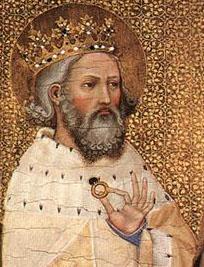
Edward the Confessor (about 1003-1066)

Westminster Abbey

Westminster Abbey as it is today

Charles I (1600-1649) would not accept Parliament’s authority
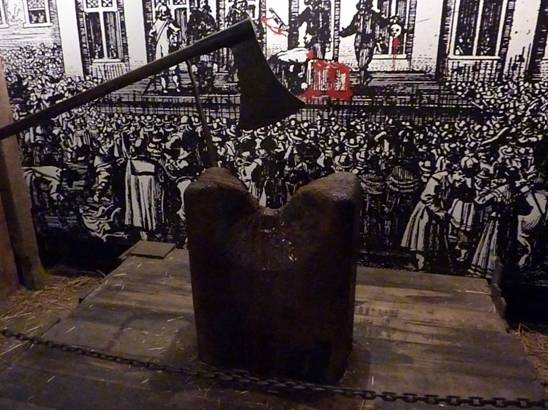
Charles I was executed in January 1649 outside the Palace of Westminster
He wore two shirts to keep him warm; he didn’t want people to think he was shivering from fear –
the shirts have been kept and still have the blood stains on them
(This is not the actual block used)
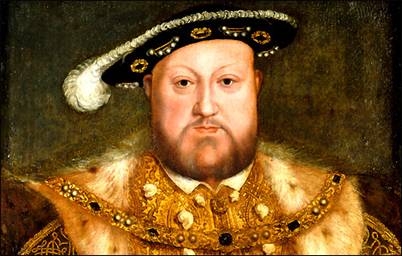
Henry VIII (1491-1547)

Cardinal Wolsey

The Banqueting Hall is the only part of The Palace of Whitehall left after a fire in 1698

George III (1738-1820)

The fire of 1834

Tally sticks – we still use the verb ‘to tally’ sometimes when we mean to reconcile (match up)
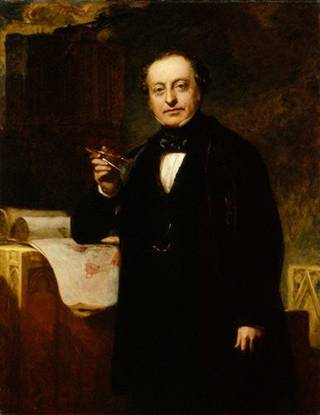
Charles Barry

Pugin

The House of Commons

The House of Lords
(where the Queen sometimes sits on one of her thrones)

The Victoria Tower
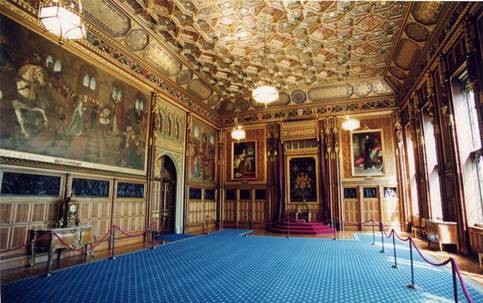
Queen’s Robing Room – tourists can visit this room in the summer

The Central Lobby lies below the Central Tower
You sometimes see a reporter talking to camera here on the news

Westminster Hall

George IV’s coronation banquet was held in Westminster Hall in 1821

A view of the river

Westminster Bridge with horse-drawn traffic

The Palace of Westminster is known as the Mother of Parliaments

Westminster Bridge full of tourists on a very hot day

The view of the Palace of Westminster from the River Thames

There are two riverside restaurants –
one for the House of Lords one for the House of Commons

The Elizabeth Tower was named in 2012

The House of Commons end of the palace

Big Ben is inside this tower

The gold adornment glints in the sunshine
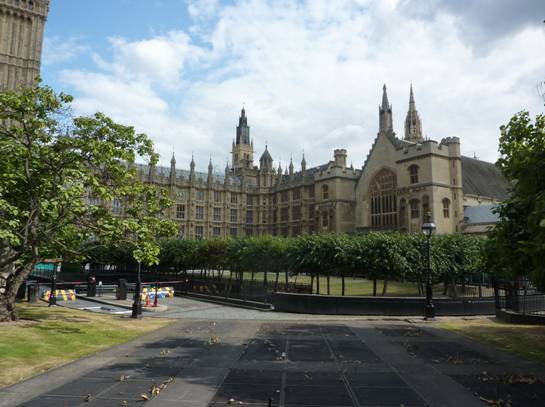
The House of Commons

Westminster Hall on the right

A statue of Oliver Cromwell stands outside the side of Westminster Hall

Oliver Cromwell was the leader of the Parliamentarian Army

Armour of a Parliamentarian soldier
(Commonwealth 1649 – 1660)

The parliamentarians were sometimes called ‘Roundheads’ because their helmets were a round shape
and their hairstyles underneath were often cropped to the same shape!

Oliver Cromwell’s death mask – Cromwell died of natural causes

Richard I is one of our most famous kings

Richard I is also known as Richard the Lionheart

The Central Tower with ventilation shafts

The Victoria Tower is at the House of Lords end of the palace

The Victoria Tower

The monarch’s entrance

The gate leads into the Victoria Tower

The gates are decorated with gold

The Jewel Tower is opposite the Palace of Westminster

The Jewel Tower is now owned by English Heritage
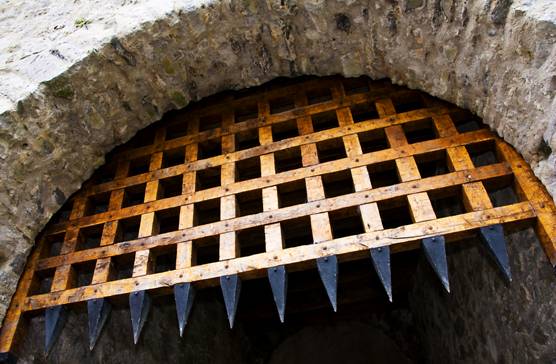
A portcullis – the front door of a castle
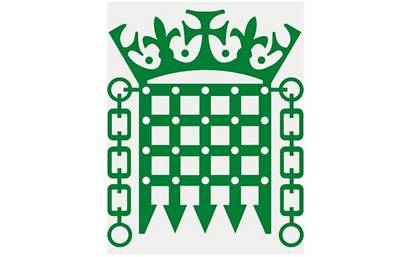
The emblem of Parliament

Big Ben


 THE SALTY SAM NEWS DESK
THE SALTY SAM NEWS DESK

Bill and Bob have prepared a puzzle for the news desk this week which fits in with the theme of the blog post.
In order to solve the puzzle, you need to add words to the word ‘house’. The definitions of the words are given.
They hope you will enjoy it.
- a group of people living in a house = a house _ _ _ _
- a female servant that works in a house = a house _ _ _ _
- a party held in a house that a person or family has just moved into = a house _ _ _ _ _ _ _
- a permanent residence floating on a river = a house _ _ _ _
- cleaning a house = house _ _ _ _


Did you know?
 The favourite snack in the Palace of Westminster is Jaffa cakes.
The favourite snack in the Palace of Westminster is Jaffa cakes.
 The red lines drawn on the floor of the House of Commons are two sword lengths apart so that people from different sides of the chamber can’t start fighting with each other.
The red lines drawn on the floor of the House of Commons are two sword lengths apart so that people from different sides of the chamber can’t start fighting with each other.
 There are hooks inside the lifts exclusively designed to hang your sword up when you travel in them.
There are hooks inside the lifts exclusively designed to hang your sword up when you travel in them.
 Smoking is banned inside the building but there is always a full snuff box by the front door.
Smoking is banned inside the building but there is always a full snuff box by the front door.
 There is a very large mouse population inside the building. (I wonder if they are related to my lighthouse mice.
There is a very large mouse population inside the building. (I wonder if they are related to my lighthouse mice. ![]() )
)


*********************
TO ADVERTISE ON THIS BLOG
PLEASE CONTACT:
christina.sinclair.ads@aol.co.uk
*********************


Crafty Tip
Here is a pattern to make a little house brooch. You will need to learn how to knit purl stitches before you can do it.

HOUSE BROOCH (KNlT TWO)
Using 3¼mm knitting needles and green 4ply yarn cast on 12 stitches
Stocking stitch 6 rows
Change to red 4ply yarn and continue in garter stitch starting with a knit row – increase 1 stitch at the beginning of the next 2 rows (14sts)
Decrease 1 stitch at the beginning of the next 4 rows (10sts)
Cast off
Using Swiss darning put the doors and windows on one of the house sides.
Then add some frames to the windows using embroidery thread.
|
V |
V |
V |
V |
V |
V |
||||||
|
V |
V |
V |
V |
V |
V |
||||||
|
V |
V |
||||||||||
|
V |
V |
With right sides together sew along the base, walls and sides of the roof. Turn the house right sides out, tuck all the ends of yarn inside and sew along the top of the roof.
Pull the chimney up into a point and sew a brooch pin to the back wall of the house.


BLOW MY FOGHORN!!!

PLUS
Salty Sam fans can join in with their comments and share them with children all over the world. You will need to ask permission if you are not an adult.
Enter your e-mail address to subscribe to my blog and receive new Salty Sam Blog Posts for free by e-mail every week. Your address will be kept private and will not be shared with any third party.
Sign me up at the side bar




lt’s the Weekend!

HOW TO MAKE KNlTTED HOUSE PLAQUES
If you don’t like knitting with 4ply yarn, you could make a little house in double knitting yarn and perhaps sew it to the end of a scarf to make it look more interesting, or even make a few and sew them along the base of a jumper to make a row of houses.
HOUSE PLAQUE (KNIT TWO)
Using 4mm knitting needles and white dk yarn cast on 12 stitches
Knit 8 rows of stocking stitch
Change to pink or red dk yarn and continue in garter stitch
Increase 1 stitch at the beginning of the next two rows
Decrease at the beginning of the next 6 rows
Cast off
TO MAKE UP
Using Swiss darning, decorate one side of the house with a door and four windows then add frame detail on top of that with embroidery thread or thin yarn.
|
V |
V |
V |
V |
||||||||
|
V |
V |
V |
V |
||||||||
|
V |
V |
V |
V |
V |
V |
||||||
|
V |
V |
V |
V |
V |
V |
||||||
|
V |
V |
Then with right sides together sew the front and back together along the base, walls and sides of roof.
Turn right sides out and sew along the top of the roof. Pull up the ends of the roof and you will see two chimney pots appearing.

And this house can be put on a jumper for your Salty Sam toy. (Or even one of your own jumpers.)

HOUSE MOTIF (KNIT ONE)
Using 4mm knitting needles and white dk yarn cast on 15 stitches
Knit 12 rows of stocking stitch
Change to pink or red dk yarn and continue in garter stitch
Increase 1 stitch at the beginning of the next two rows
Decrease at the beginning of the next 8 rows
Cast off 12 stitches knit to end
Knit 2 rows
Cast off
|
V |
V |
V |
V |
V |
V |
|||||||||
|
V |
V |
V |
V |
V |
V |
|||||||||
|
V |
V |
V |
V |
V |
V |
|||||||||
|
V |
V |
V |
V |
V |
V |
V |
V |
V |
||||||
|
V |
V |
V |
V |
V |
V |
V |
V |
|||||||
|
V |
V |
V |
V |
V |
V |
V |
V |
V |
||||||
|
V |
V |
V |
||||||||||||
|
V |
V |
V |

SALTY SAM HOUSE JUMPER FRONT AND BACK (KNIT TWO)
Using 3½mm knitting needles and green dk yarn cast on 52 stitches
K3 (p2, k2) repeat the last 4 stitches to last 3 stitches k3
P3 (k2, p2) repeat the last 4 stitches to last 3 stitches p3
Repeat the last 2 rows 3 times (8 rows of ribbing)
Change to 4mm knitting needles
Stocking stitch 10 rows in green
Stocking stitch 38 rows in blue
Cast off 12 stitches in the next 2 rows (24 stitches)
Change to 3½mm knitting needles
K3 (p2, k2) repeat the last 4 stitches to last 3 stitches k3
P3 (k2, p2) repeat the last 4 stitches to last 3 stitches p3
Repeat the last 2 rows 3 times (8 rows of ribbing)
SLEEVES (KNIT TWO)
Using 3½mm knitting needles and green dk yarn cast on 40 stitches
K3 (p2, k2) repeat the last 4 stitches to last 3 stitches k3
P3 (k2, p2) repeat the last 4 stitches to last 3 stitches p3
Repeat the last 2 rows 3 times (8 rows of ribbing)
Change to 4mm knitting needles
Stocking stitch 16 rows in green
Stocking stitch 22 rows in blue
Cast off
TO MAKE UP
(Using the blue yarn) sew up the right shoulder seam but the left only 1cm up from the shoulder side (not neck side) with right sides facing.
Fold the sleeves in half lengthways in order to find the centre. Match this centre up to the shoulder seam and sew across the top of the sleeves.
Then sew under sleeve and side seams.
Use blue yarn to sew up the blue parts and green to sew up the green parts.
Using sewing thread, sew a snap fastener to the outside corners of the collar – this will then turn over to hide the snap fastener.
Using Swiss darning embroider a white picket fence along the top of the ribbing and sew on the knitted house motif.

Please note that the material on this blog is for personal use and for use in classrooms only.
It is a copyright infringement and, therefore, illegal under international law to sell items made with these patterns.
Use of the toys and projects is at your own risk.
©Christina Sinclair Designs 2015

Answers to the News Desk Quiz
- a household
- a housemaid
- a housewarming
- a houseboat
- housework

A housemaid

A houseboat



Wow, wonderful weblog structure! How lengthy have you been running a blog for? you make running a blog glance easy. The total glance of your website is great, as smartly as the content material!
Thank you for your kind comments CP! My blog is nearly five years old so there are plenty more posts for you to read…